
Two electrons, each with mass m and charge q, are released from positions very far from each other. With respect to a certain reference frame, electron A has initial nonzero speed v toward electron B in the positive x direction, and electron B has initial speed 3v toward electron A in the negative x direction. The electrons move directly toward each other along the x axis (very hard to do with real electrons). As the electrons approach each other, they slow due to their electric repulsion. This repulsion eventually pushes them away from each other. What is the minimum separation rmin that the electrons reach? Express your answer in term of q, m, v, and k (where k=14πϵ0)

Answers: 3
Other questions on the subject: Physics

Physics, 22.06.2019 10:00, nayellisoto15
Asap and show ! a 14 kg rock starting from rest free falls through a distance of 5.0 m with no air resistance. find the momentum change of the rock caused by its fall and the resulting change in the magnitude of earths velocity. earth mass is 6.0 * 10^24 kg. show your work assuming the rock earth system is closed.
Answers: 2

Physics, 22.06.2019 17:00, jenn8055
In the future, people will only enjoy one sport: electrodisc. in this sport, you gain points when you cause metallic discs hovering on a field to exchange charge. you are an electrodisc player playing the popular four disc variant. the disks have charges of qa = −8.0 µc, qb = −2.0 µc, qc = +5.0 µc, and qd = +12.0 µc. (1) you bring two disks together and then separate them. you measure the resulting charge of these two disks and find that it is +5.0 µc per disk. which two disks did you bring together? (a) a and b (b) a and c (c)a and d (d)b and c(e) b and d (f) c and d. (2) you bring three disks together and then separate them. you measure the resulting charge of these three disks and find that it is +3.0 µc per disk. which three disks did you bring together? a, b, and c (a) a, b, and d (c) a, c, and d (d) b, c, and d. (3) given the resulting charge of each disk measured in (b) is +3.0 µc, how many electrons would you need to add to a disk of this charge to electrically neutralize it? electrons
Answers: 3


Physics, 23.06.2019 00:00, elyssa34972
Examine the drawing of a molecule. each ring represents an atom of nitrogen (n). what’s the chemical formula of this substance?
Answers: 2
Do you know the correct answer?
Two electrons, each with mass m and charge q, are released from positions very far from each other....
Questions in other subjects:





History, 24.04.2020 00:34


History, 24.04.2020 00:34

Mathematics, 24.04.2020 00:34



 .
. .................................................................(1)
.................................................................(1) ..................................................................(2)
..................................................................(2)



 (1)
(1) (2)
(2) is the final electric potential energy of the system, with
is the final electric potential energy of the system, with 






